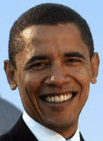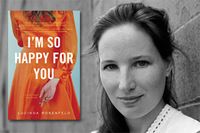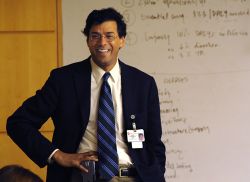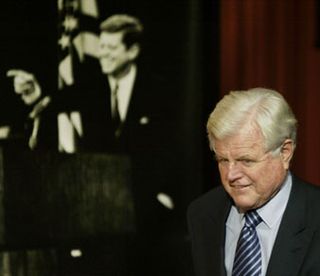 In the continuing controversy surrounding the president's U.S. citizenship, a new fringe group informally known as “Afterbirthers” demanded Monday the authentication of Barack Obama's placenta from his time inside his mother's womb. “All we are asking is that the president produce a sample of his fetal membranes and vessels—preferably along with a photo of the crowning and delivery—and this will all be over,” said former presidential candidate and Afterbirthers spokesman Alan Keyes, later adding that his organization would be willing to settle for a half-liter of maternal cord plasma.
In the continuing controversy surrounding the president's U.S. citizenship, a new fringe group informally known as “Afterbirthers” demanded Monday the authentication of Barack Obama's placenta from his time inside his mother's womb. “All we are asking is that the president produce a sample of his fetal membranes and vessels—preferably along with a photo of the crowning and delivery—and this will all be over,” said former presidential candidate and Afterbirthers spokesman Alan Keyes, later adding that his organization would be willing to settle for a half-liter of maternal cord plasma.
More here.

People are drinking again in public in Baghdad for the first time since 2003; at a newly opened nightclub only ten minutes’ drive from Sadr City, the owner smiled broadly. “No more Jeish al-Mehdi,” he said. When I asked if all this was really attributable to the containment wall, one of my friends chimed in, smiling now too, “It is like zoo.” On the other side of the wall, however, the shop owners of Sadr City are not so happy. “Your business dies because of these stones,” one shop owner told me. We were standing on the eastern edge of the Sadr City, near where another wall had been built, running almost the entire length of the district. “The Americans . . . the Americans . . . This is their plan, not Iraqis. They directed the Iraqi government to do this—to hurt Sadr City and especially the Sadr movement. The neighborhood is already suffocating. And they put these stones to suffocate it more?” As we talked, an old woman squeezed through an opening in the barrier just large enough for a single person. After her came another, a man carrying a canister of cooking gas who tossed his purchase over the wall to a helpful bystander before squeezing through the crack and continuing on his way. “Is this Iraq?” the shop owner asked.
more from David Enders at VQR here.

Every time we speak of certain cities, we are saying something about Venice. When CNN.com asked its readers for their thoughts on the reconstruction of New Orleans, one Mississippi resident responded, “New Orleans has always had a European feel to it. Why not enhance this by making it like Venice, Italy? Leave the areas that didn’t flood as they are and make the rest like Venice with canals for roads and the houses and properties on concrete ‘islands.'” This was not one individual’s fantasy. Elsewhere, numbers of Americans confirmed the idea. “Rebuild New Orleans as a water-street city,” wrote a blogger. “It’s the natural way to solve all its problems,” a post that received a significant number of affirmative comments: “Good idea …”; “I really like this idea”; “It’s interesting that you’ve posted this idea, because I was thinking the exact same thing today”; “I think that this is a beautiful idea as long as someone finds a new home for all of the alligators.” As the hurricane was a “natural” disaster, Venice would be the “natural” outcome. Where did this sort of thinking come from? Bombay, which in early August suffered the worst floods in its history—at least a thousand dead, and twenty million displaced or homeless—never aroused a whisper of Venice. Its charming colonial architecture aside, to most observers, Bombay is already a disaster, not merely one waiting to happen.
more from Nikil Saval at n+1 here.

In the summer of 2007, Mahmood Mamdani found himself at a meeting of activists and politicians, listening to sentiments that had by then become quite common among a certain class of politically active Americans. The speakers were calling on the United Nations to send peacekeepers to Darfur. Fed up with the inability of African Union troops–who were already on the ground in western Sudan–to stop the ongoing bloodshed, they insisted that U.N. forces could do better. The United Nations, explained one politician, echoing a view you could have heard on any number of college campuses at the time, would grant “mercy” to the people of Darfur. Mamdani was appalled at what he was hearing. “The naivete of these assumptions was breathtaking,” he fumes in his new book, as he recalls the meeting. And it was not just this gathering that irked him. Other activists of his acquaintance were going even further. One friend was hoping that Americans would “impose a no-fly zone and … hit selected targets.” Meanwhile a “highly respected activist” had even raised the possibility of the United States sending its own ground troops to Sudan, or mustering troops from other countries for the humanitarian mission. Could Americans solve the problems of Darfur? an incredulous Mamdani asked. “Not really,” the activist replied.
more from Richard Just at TNR here.
North
Slow as sperm whales
we glide through the gloom
which is white
here on the heath
It holds fast to its own
conceding only
one post at a time
For an instant they flash
on the side of the road
like the little girl’s matches
in the fairytale
lighting us
until we return
to the hole in the ice
to breathe
by Gerður Kristný
Translation: Victoria Cribb
From: Höggstaður
Publisher: Mál og menning, Reykjavik, 2007
Fahad Rafique Dogar in Pakistan's The News (via Five Rupees, via Yes and No):
This is with reference to Dr A Q Khan’s column “Science of computers — part I” which appeared in your pages on Aug 19.
 1. Dr Khan writes: “The computer is an essential part of 21st century life. Computer science is a fast-moving subject that gives rise to a range of interesting and often challenging problems. The implementation of today’s complex computer systems requires the skills of a knowledgeable and versatile computer scientist. Artificial intelligence — the study of intelligent behaviour — is having an increasing reference on computer system design. Distributed systems, networks and the internet are now central to the study of computing, presenting both technical and social challenges.”
1. Dr Khan writes: “The computer is an essential part of 21st century life. Computer science is a fast-moving subject that gives rise to a range of interesting and often challenging problems. The implementation of today’s complex computer systems requires the skills of a knowledgeable and versatile computer scientist. Artificial intelligence — the study of intelligent behaviour — is having an increasing reference on computer system design. Distributed systems, networks and the internet are now central to the study of computing, presenting both technical and social challenges.”
Now compare this to the first paragraph of Undergraduate Prospectus 2009, University of Sussex(www.sussex.ac.uk/units/publications/ugrad2009/subjects/computing):
“Computing is an essential part of 21st-century life, and is an exceptionally fast-moving subject that gives rise to a range of interesting and challenging problems. The implementation of today’s complex computing systems, networks and multimedia systems requires the skills of knowledgeable and versatile computer scientists. Computer networks and the internet are now central to the study of computing and information technology, presenting both technical and social challenges. Artificial intelligence (AI) — the study of intelligent behaviour — is having an increasing influence on computer system design.”
More here.
From Salon:
 In popular culture, female friendships often fall into two extreme camps: There are the giggling, cocktail-swilling BFFs of “Sex and the City” and the backstabbing bitches of “Gossip Girl” and “The Hills.” In real life, female friendship is a much trickier beast, filled with slippery contradiction and embarrassed envy, territory that Lucinda Rosenfeld stakes out in her new comic novel, “I'm So Happy for You.”
In popular culture, female friendships often fall into two extreme camps: There are the giggling, cocktail-swilling BFFs of “Sex and the City” and the backstabbing bitches of “Gossip Girl” and “The Hills.” In real life, female friendship is a much trickier beast, filled with slippery contradiction and embarrassed envy, territory that Lucinda Rosenfeld stakes out in her new comic novel, “I'm So Happy for You.”
The book tracks the relationship between Wendy and Daphne, two college friends stumbling through their 30s in New York. But when Daphne — once the lonelyheart prone to making melodramatic late-night phone calls and falling for the wrong men — finds sudden bliss, Wendy finds herself mired in the kind of jealousy and self-pity that can get you blacklisted from the ya-ya sisterhood of the traveling pants.
More here.
From Scientific American:
 Medical research can have big rewards—both in gratifying discoveries and in potentially turning them into profitable treatments. To achieve the former, researchers work hard. Very hard. To obtain the latter, they can start companies or sign commercial funding agreements—well before testing is over. So, do patients undergoing clinical trials for new treatments have a right to know about these monetary interests?
Medical research can have big rewards—both in gratifying discoveries and in potentially turning them into profitable treatments. To achieve the former, researchers work hard. Very hard. To obtain the latter, they can start companies or sign commercial funding agreements—well before testing is over. So, do patients undergoing clinical trials for new treatments have a right to know about these monetary interests?
Legally, no. And no empirical data has tied researchers' financial interests in a study to negative outcomes for patients. In the past several years, however, more findings suggest that, ethically, patients should be informed prior to participating in a trial.
More here.
Thursday, August 27, 2009
Marina Warner in the London Review of Books:
 Dubravka Ugrešić’s Baba Yaga Laid an Egg is the latest, most inventive and most substantial volume in Canongate’s series of revisioned myths. The first was Margaret Atwood’s Penelopiad, a harsh retelling in Penelope’s voice of the concluding scenes of the Odyssey. With her own special bite, Atwood singles out for dramatic treatment the girls who worked in the palace and fraternised with Penelope’s suitors; she reminds us how pitilessly Odysseus orders them to be hanged, every one. The resonances with contemporary matters, which this series of books aims to stir, are powerful in this new handmaid’s tale. Karen Armstrong opened the series with an introduction that stressed myth’s archaic origins and links to religion and ritual, to national or tribal identity. This is the ontological version of myth, which assumes that the stories connect to a metaphysical belief system that maps onto a culture’s history and ethics.
Dubravka Ugrešić’s Baba Yaga Laid an Egg is the latest, most inventive and most substantial volume in Canongate’s series of revisioned myths. The first was Margaret Atwood’s Penelopiad, a harsh retelling in Penelope’s voice of the concluding scenes of the Odyssey. With her own special bite, Atwood singles out for dramatic treatment the girls who worked in the palace and fraternised with Penelope’s suitors; she reminds us how pitilessly Odysseus orders them to be hanged, every one. The resonances with contemporary matters, which this series of books aims to stir, are powerful in this new handmaid’s tale. Karen Armstrong opened the series with an introduction that stressed myth’s archaic origins and links to religion and ritual, to national or tribal identity. This is the ontological version of myth, which assumes that the stories connect to a metaphysical belief system that maps onto a culture’s history and ethics.
But, to borrow Christopher Warnes’s contrast between ontology and irreverence in his Magical Realism and the Postcolonial Novel,[*] the approach of contemporary retellers of myths, including Ugrešić, makes clear that the readers they have in mind aren’t concerned with sacred matters and are impatient with spiritual meaning. These writers have adopted a looser, secular conception of myth, which flattens hierarchies between faith and superstition, and doesn’t discriminate, as a Victorian anthropologist would have done, between high and low culture, between stories about gods, which are rooted in belief and enacted through ritual, and tales of goblins and fairies and witches, told to raise shivers of pleasurable fear on a dark winter night. By uncoupling itself from belief, the vision of myth/fairy tale can be angled more sharply towards other tasks.
More here.
From The Economist:
 That the risk-taking end of the financial industry is dominated by men is unarguable. But does it discriminate against women merely because they are women? Well, it might. But a piece of research just published in the Proceedings of the National Academy of Sciences by Paola Sapienza of Northwestern University, near Chicago, suggests an alternative—that it is not a person’s sex, per se, that is the basis for discrimination, but the level of his or her testosterone. Besides being a sex hormone, testosterone also governs appetite for risk. Control for an individual’s testosterone levels and, at least in America, the perceived sexism vanishes.
That the risk-taking end of the financial industry is dominated by men is unarguable. But does it discriminate against women merely because they are women? Well, it might. But a piece of research just published in the Proceedings of the National Academy of Sciences by Paola Sapienza of Northwestern University, near Chicago, suggests an alternative—that it is not a person’s sex, per se, that is the basis for discrimination, but the level of his or her testosterone. Besides being a sex hormone, testosterone also governs appetite for risk. Control for an individual’s testosterone levels and, at least in America, the perceived sexism vanishes.
More here.
Stanley Fish in the New York Times:
 A few years ago, when I was grading papers for a graduate literature course, I became alarmed at the inability of my students to write a clean English sentence. They could manage for about six words and then, almost invariably, the syntax (and everything else) fell apart. I became even more alarmed when I remembered that these same students were instructors in the college’s composition program. What, I wondered, could possibly be going on in their courses?
A few years ago, when I was grading papers for a graduate literature course, I became alarmed at the inability of my students to write a clean English sentence. They could manage for about six words and then, almost invariably, the syntax (and everything else) fell apart. I became even more alarmed when I remembered that these same students were instructors in the college’s composition program. What, I wondered, could possibly be going on in their courses?
I decided to find out, and asked to see the lesson plans of the 104 sections. I read them and found that only four emphasized training in the craft of writing. Although the other 100 sections fulfilled the composition requirement, instruction in composition was not their focus. Instead, the students spent much of their time discussing novels, movies, TV shows and essays on a variety of hot-button issues — racism, sexism, immigration, globalization. These artifacts and topics are surely worthy of serious study, but they should have received it in courses that bore their name, if only as a matter of truth-in-advertising.
As I learned more about the world of composition studies, I came to the conclusion that unless writing courses focus exclusively on writing they are a sham, and I advised administrators to insist that all courses listed as courses in composition teach grammar and rhetoric and nothing else. This advice was contemptuously dismissed by the composition establishment, and I was accused of being a reactionary who knew nothing about current trends in research.
More here.

On a cold spring evening, a cluster of hipsters, aging hippies, writers, and professors convenes at 680 Park Avenue, scaling the spiral staircase that Michelle Pfeiffer rather more elegantly ascended in the movie version of The Age of Innocence. The century-old mansion once housed the Soviet Mission to the United Nations; today it is the headquarters of the Americas Society, a non-profit body created with Rockefeller money, and dedicated to fostering cultural and political ties between the US and its neighbours in the western hemisphere. Perched on chairs below the ballroom’s glittering chandeliers, the audience listens as Daniel Shapiro, a New York poet and translator who serves as the society’s director of literature, introduces a blue-chip panel speaking on the topic of Jack Kerouac: An Unlikely Franco-American Writer. Franco-American? Bien sûr. Kerouac’s given name wasn’t Jack; it was Jean-Louis. His mother tongue wasn’t English; it was French. He was born in Lowell, Massachusetts, the son of immigrants from Quebec; on his mother’s side, he was related to René Lévesque. Indeed, tonight’s event is co-sponsored by the Association internationale des études québécoises and the Quebec government’s office in New York.
more from Mark Abley at The Walrus here.

In 1492, Columbus sailed west. In 1991, the Soviet Union collapsed. These two events bracketed the European age. Once, Mayans lived unaware that there were Mongols, who were unaware there were Zulus. From the 15th century onwards, European powers collectively overwhelmed the world, creating the first truly global geopolitical system in human history, to the point where the fate of Australian Aborigines was determined by British policy in Ireland and the price of bread in France turned on the weather in Minnesota. Europe simultaneously waged a 500-year-long civil war of increasing savagery, until the continent tore itself apart in the 20th century and lost its hold on the world. After the collapse of the Soviet Union, there was no longer a single European nation that could be considered a global power of the first rank. Another unprecedented event took place a decade or so earlier. For 500 years, whoever controlled the North Atlantic controlled Europe’s access to the world and, with it, global trade. By 1980, the geography of trade had shifted, so that the Atlantic and Pacific were equally important, and any power that had direct access to both oceans had profound advantages. North America became the pivot of the global system, and whatever power dominated North America became its centre of gravity. That power is, of course, the United States.
more from George Friedman at The New Statesman here.

What is never in doubt is Dylan’s enduring ability to connect with a new audience who are discovering his older classics for the first time. Still alive, still active, still Number One, he is taking us into uncharted territory in what was once considered a young man’s game. Together Through Life, indeed. The new record is lazy and charming, full of riffs borrowed and blue, befitting a songwriter with nothing left to prove. For someone who never looked back, and advised against it, most of the “late style” lyrics are nostalgic, as are the accompanying interviews: radio isn’t as good as it was when he was young, people aren’t in love like they used to be. In fact, quite how much of the album Dylan wrote is obscure. Those lines not purloined from old blues songs may well have been written by The Grateful Dead’s lyricist Robert Hunter, whom Dylan “hired” as a collaborator. So now is the perfect time to take stock of the catalogue. Clinton Heylin has been an indefatigable chronicler of Dylan since the 80s when he co-founded Wanted Man, The Bob Dylan Information Office, with its fanzine/journal the Telegraph, under the editorship of John Bauldie. In the world of Wanted Man, Heylin was an extremely affable and opinionated conversationalist, always the man most likely to turn his passion into a career. He has written the best Dylan biography (Behind The Shades, 2001, since revised as Behind The Shades Revisited, 2003) and a day-to-day guide (Stolen Moments, 1988). His Bob Dylan: The recording sessions, 1997, followed soon after Marc Lewisohn’s classic The Complete Beatles Recording Sessions, and the new book capitalizes on Ian MacDonald’s song-by-song Beatles book Revolution In The Head (to the title of which Heylin’s obviously alludes).
more from Wesley Stace at the TLS here.
The Murmur of Material
In Gevgelia there is a man
Who once was and still is just a man
Even back then when one ought to have been
Either a Cro or a Srb
A Mac or an Alb
So what?
Someone will say.
Big deal!
Others will add.
And in the ensuing
Murmur of dissonant voices
I will yet again fail to hear
Whether any of them really tried?
by Perdrag Lucić
Translation: Damir Šodan
Read more »
From Harvard Magazine:
 If Gawande is an unlikely surgeon, envisioning a career in medicine, more generally, was easy. He grew up in Athens, Ohio, the son of a urologist father and a pediatrician mother, and he has often said that following them into the field seemed so inevitable that he tried every way he could think of to avoid it. Careers he considered along the way included philosophy and politics; they did not include writing. His first published writing for a popular audience, in 1996, came at the invitation of Jacob Weisberg, a friend from Gawande’s time at Oxford as a Rhodes scholar. Despite Gawande’s lack of writing experience, Weisberg, who helped found the online magazine Slate and later edited it, had a hunch that his friend would be good at explaining medicine to a lay audience. Besides, he was encouraged by what he knew of Gawande’s personal qualities: “Atul goes at everything in an incredibly focused, driven way. The odds of him not making something work are a lot lower than they would be with anybody else.”
If Gawande is an unlikely surgeon, envisioning a career in medicine, more generally, was easy. He grew up in Athens, Ohio, the son of a urologist father and a pediatrician mother, and he has often said that following them into the field seemed so inevitable that he tried every way he could think of to avoid it. Careers he considered along the way included philosophy and politics; they did not include writing. His first published writing for a popular audience, in 1996, came at the invitation of Jacob Weisberg, a friend from Gawande’s time at Oxford as a Rhodes scholar. Despite Gawande’s lack of writing experience, Weisberg, who helped found the online magazine Slate and later edited it, had a hunch that his friend would be good at explaining medicine to a lay audience. Besides, he was encouraged by what he knew of Gawande’s personal qualities: “Atul goes at everything in an incredibly focused, driven way. The odds of him not making something work are a lot lower than they would be with anybody else.”
More here.
From Scientific American:
 Thrill seeking and poor judgment go hand in hand when it comes to teenagers—an inevitable part of human development determined by properties of a growing but immature brain. Right? Not so fast. A study being published tomorrow turns that thinking upside down: The brains of teens who behave dangerously are more like adult brains than are those of their more cautious peers. Psychologists have long believed that the brain's judgment-control systems develop more slowly than emotion-governing systems, not maturing until people are in their mid-20s. Hence, teens end up taking far more risks than adults do. Evidence supporting this idea comes from studies looking at functional and structural properties of gray matter, the important part of the brain that contains the neurons that relay brain signals.
Thrill seeking and poor judgment go hand in hand when it comes to teenagers—an inevitable part of human development determined by properties of a growing but immature brain. Right? Not so fast. A study being published tomorrow turns that thinking upside down: The brains of teens who behave dangerously are more like adult brains than are those of their more cautious peers. Psychologists have long believed that the brain's judgment-control systems develop more slowly than emotion-governing systems, not maturing until people are in their mid-20s. Hence, teens end up taking far more risks than adults do. Evidence supporting this idea comes from studies looking at functional and structural properties of gray matter, the important part of the brain that contains the neurons that relay brain signals.
At least two observations undermine this theory, however. First, American-style teen turmoil is absent in more than 100 cultures around the world, suggesting that such mayhem is not biologically inevitable. Second, the brain itself changes in response to experiences, raising the question of whether adolescent brain characteristics are the cause of teen tumult or rather the result of lifestyle and experiences. Because brain research is virtually always correlational in design, determining whether brain properties are causes or effects is impossible.
More here.
Wednesday, August 26, 2009
 Robert Scheer in The Nation:
Robert Scheer in The Nation:
Unable to move with his brothers' intellectual alacrity, sometimes plodding in impromptu expression but smooth and skillful while reading from a script, the youngest Kennedy made up for his shortcomings early in his Senate career by resolutely working the substance of issues. His principled determination, plus his capacity to truly care about the real-world outcomes of legislation for ordinary people rather than its impact on his or anyone else's election, became his signature qualities as a lawmaker. But for those same reasons, he also wanted legislation passed, and his ability to work with the opposition, as he did three years ago with John McCain on immigration reform, now grants him a legacy as one of the nation's great senators.
Oddly enough, for one born into such immense familial expectations, he was a surprisingly accessible and down-to-earth politician in the eyes of most journalists who covered him. I think of him as always authentic and never oily. As opposed to most politicians, the offstage Ted Kennedy was the more appealing one.
Although he excelled as an orator, never more so than delivering the speech that Bob Shrum crafted for him at the 1980 Democratic Convention but which was informed by Kennedy's own deeply felt passion, it was in his less choreographed moments that he was at his best.
 Michael White makes the case over at Adaptive Complexity (via Sci Tech Daily):
Michael White makes the case over at Adaptive Complexity (via Sci Tech Daily):
Many of these researchers don’t understand what it means to test a theory. They build these complex models, which involves making important assumptions that could easily be wrong, and then if their models fit existing data, they think the model is right.
Hence you get this McColloh guy claiming that his network analysis model was responsible for a big drop in sniper attacks, ignoring the much more obvious and plausible causes for the drop in violence: the addition of 30,000 troops and the US Military’s major new approach to counterinsurgency implemented by Petraeus. The network researchers can’t justify ruling out the more obvious explanation; their only retort is to say that their critics don’t understand their fancy methods. (Which is not true in many cases – there are plenty physicists, biologists, and economists who understand the mathematical/statistical/computational techniques, who are bothered by the scientific culture of complex systems research.)
This a dangerous mindset to have in science. What these researchers are doing is practicing a sham form of science called by Feynman Cargo Cult Science:
There is also a more subtle problem. When you have put a lot of ideas together to make an elaborate theory, you want to make sure, when explaining what it fits, that those things it fits are not just the things that gave you the idea for the theory; but that the finished theory makes something else come out right, in addition.
And no, that does not mean simply training your model on half of your data set and showing that you can effectively explain the other half of your data.
In the continuing controversy surrounding the president's U.S. citizenship, a new fringe group informally known as “Afterbirthers” demanded Monday the authentication of Barack Obama's placenta from his time inside his mother's womb. “All we are asking is that the president produce a sample of his fetal membranes and vessels—preferably along with a photo of the crowning and delivery—and this will all be over,” said former presidential candidate and Afterbirthers spokesman Alan Keyes, later adding that his organization would be willing to settle for a half-liter of maternal cord plasma.
